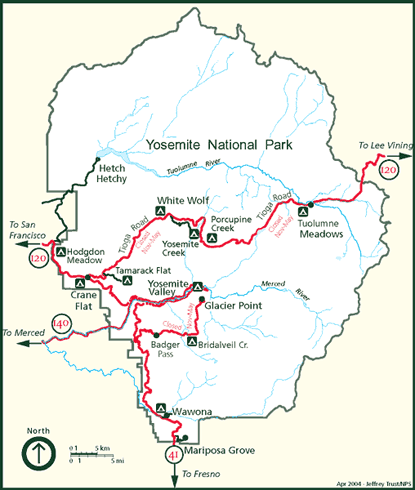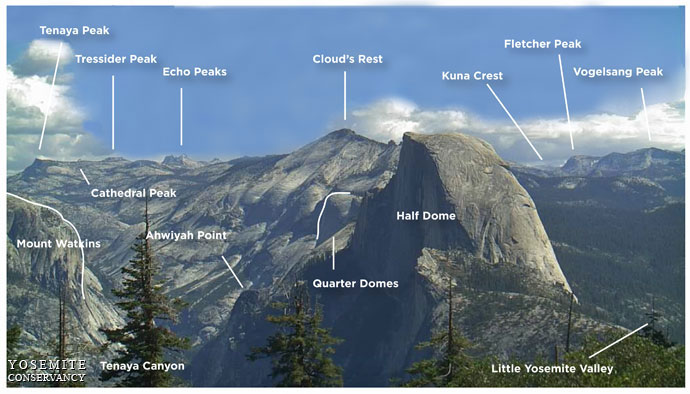Frecuent Asked Questions
Accessibility
Keeping in mind that GPS units often provide incorrect driving directions in and around Yosemite, please take a look at our driving directions map.

Wawona Road (Highway 41)
Maximum vehicle length: 45 feet (for single vehicles).
Height restrictions: Wawona Tunnel, into Yosemite Valley: 10 feet 2 inches at curb; from Yosemite Valley,
13 feet 6 inches at curb (the height of the tunnel at the white fogline is higher and full sized tour buses are able to drive
through the tunnel while remaining in their lane).
Seasons: Open all year (chains may be required in winter).
El Portal Road (Highway 140)
Maximum vehicle length: 45 feet for single vehicle, 60 feet for combination vehicle, 35 feet for towed vehicle from hitch
to rear bumper
Height restrictions: 12 feet 10 inches
Seasons: Open all year (chains may be required in winter).
Note:
Highway 140 outside the park (between El Portal and Mariposa) can accommodate vehicles up to 45 feet long,
effective June 27, 2008. The 28-foot total vehicle length limit will no longer be in effect beginning June 27, 2008.
Big Oak Flat Road (Highway 120)
Maximum vehicle length: 45 feet for single vehicle.
Height restrictions: tunnels, into Yosemite Valley: 10 feet 3 inches; from Yosemite Valley,
13 feet 8 inches (the height of the tunnel at the white fogline is higher and full sized tour buses are able to drive
through the tunnel while remaining in their lane).
Seasons: Open all year (chains may be required in winter).
Tioga Road (Highway 120)
Seasons: Closed from approximately November through May.
Overnight parking is not permitted between October 15 and the opening of the road in spring.
Read below for tips on pulling a trailer over Tioga Pass.
Glacier Point Road
Maximum vehicle length: Beyond Sentinel Dome/Taft Point trailhead, 30 feet for single vehicle, no trailers.
Buses longer than 30 feet or with capacity of 26 passengers or more are not permitted beyond Badger Pass.
Seasons: Closed from approximately November through May
(Badger Pass portion of the road is open from approximately mid December through March).
Overnight parking on the Glacier Point Road between Badger Pass and Glacier Point
is not permitted between October 15 and the opening of the road in spring.
Mariposa Grove Road
Maximum vehicle length: 25 feet; no trailers permitted.
A seven-ton weight limit may be imposed during spring.
Seasons: Closed approximately November through mid April.
Hetch Hetchy Road
Maximum vehicle length: 25 feet
Maximum vehicle width: 8 feet (mirror to mirror)
Seasons: Open all year (chains may be required in winter).
This is the only park road not open 24 hours/day, the hours below may change without notice:
April 1 to April 30: 8 am to 7 pm
May 1 to Labor Day: 7 am to 9 pm
Day after Labor Day to October 31: 8 am to 7 pm
November 1 to March 31: 8 am to 5 pm
Note:
Commercial trucking through Yosemite is prohibited.
Tips for Pulling a Trailer over Tioga Pass
Highway 120 between Tioga Pass and its junction with US 395 is a steep, winding mountain road. The steepest portion of the road is an eight-mile section that ascends about 2,500 feet (from Lee Vining toward Tioga Pass). Portions of the road have a grade as steep as eight percent.
Other considerations:
- Adhere to the towing capacity of your vehicle ( you might be able to tow a trailer that is heavier than what your vehicle is set up to tow on other roads, but it might not work if you're going up or down this grade); adjust your braking system if you can.
- Know your driving skills and what you are capable of doing.
- Many vehicles towing trailers make it up to Tioga Pass (slowly and patiently). However, you may not be able to keep up with other traffic--if you try to, your vehicle may overheat. So, don't try to drive the same speed as other cars that aren't towing vehicles; use the pullouts when you can to allow them to pass you.
- If you do break down (engine overheating, brakes fail, etc.) be aware that you might be waiting several hours for help (especially if you come through later in the day when fewer people can help you). Have a plan if you break down.
You can drive your own vehicle into and around Yosemite
(shuttle buses are not mandatory, but are recommended).
Tire chains may be required in fall, winter, and spring due to snowy or icy conditions.
It's not possible to predict when exactly they may be required since requirements are based on conditions.
When you encounter a chain control sign that indicates that your car is not exempt (i.e., that you have to put on chains), pull completely off the road into the turnout and put on your chains. Chain control signs are at locations where putting on chains is relatively safe: put your chains on there, not further down the road.
Just because you have chains or four-wheel drive doesn't mean driving in snow is easy. Even park residents who regularly commute on park roads during winter are involved in snow-related accidents. Follow these tips to reduce your chances of an accident.
The speed limit within chain control areas is 25 mph, even if other signs indicate the speed limit is higher.
And if I don't put on chains?
You will be subject to a citation (up to $5,000) if you fail to put on chains when required.
Further, if you don't have chains with you, you may have to call a tow truck to supply chains for you
(this could cost up to a few hundred dollars and is not covered by AAA; the wait can be several hours).
Countless accidents are caused by motorists who lose control because they don't have chains,
and many of those drivers have winter driving experience.
Don't be responsible for injuring someone, damaging vehicles,
or inconveniencing hundreds of other park visitors by causing an accident: use chains when required and drive with caution.
An alternative to using tire chains...
...is to park your car on Highway 140 outside Yosemite, before you encounter any chain controls
(the location of which varies based on conditions),
at a YARTS bus stop
and use YARTS
to travel into and out of Yosemite (fee required).
The Tioga Road (Highway 120 through the park, from Crane Flat to Tioga Pass) is open approximately late May through October, though these dates vary depending on conditions since 1980.
There are so many things to do in Yosemite!
Yosemite has many attractions.
It depends what you're looking for! While most people visit Yosemite during summer, there are advantages to visiting throughout the year.
The Half Dome cables are normally installed immediately before Memorial Day weekend, but this can vary depending on conditions and trail crew availability. The cables usually remain up through Columbus Day (in October).
A permit is required to hike Half Dome.
The National Park Service strongly discourages hikers from attempting the cable route when the cables are down.There are three giant sequoia groves in Yosemite National Park: the Mariposa Grove, the Tuolumne Grove, and the Merced Grove.
Horsetail Fall flows in winter and early spring, when snow is present on top of El Capitan. On sunny afternoons in mid- to late February, the setting sun can cause it to glow orange.
Frazil ice forms along Yosemite Creek, and some other creeks in Yosemite Valley, most commonly in March and April. The phenomenon is entirely weather-dependent, so it's difficult to know when exactly it may happen (or if it will happen at all).
Wildlife
Animals in the park are wild, but many are accustomed to people because they have been fed so often. It is illegal to feed any animal in the park. Feeding animals contributes to poor nutrition, ill health, and the alteration of natural behaviour patterns. Visitors who get close to or feed animals may also be bitten, scratched, or otherwise injured, or may become ill.
Yosemite's bears are always searching for food and consider anything that looks or smells like food to be food. Learn more about how to properly store your food while visiting Yosemite.
Black bears in Yosemite tend to avoid people and can be scared off.
VISITOR SERVICES
No, you don't need a reservation to visit Yosemite. However, if you plan to spend the night in Yosemite, you should have a reservation for lodging, camping, or backpacking. (Hookups are not available in any Yosemite campgrounds.)
Citizens and legal residents with permanent disabilities are entitled to a free America the Beautiful Pass that provides the holder free access to federal fee areas.
The park strives for full and equal participation for all visitors and continually upgrades facilities, programs and services to improve accessibility. The Yosemite Accessibility Guide outlines a variety of accessible services, facilities, and activities available in Yosemite.
Fee waivers are available to educational groups that meet certain criteria.
Pets are allowed in Yosemite though there are regulations one must follow.
Internet kiosks and wi-fi are both available in several locations.
AT&T: Voice and 3G (4G HSPA+) data service are available in parts of Yosemite Valley Voice and EDGE data service are available at Tuolumne Meadows.
Verizon Wireless: Voice and 3G data service are available in parts of Yosemite Valley and El Portal.
Voice and 1x data service are available in Tuolumne Meadows, Crane Flat, and Wawona.





